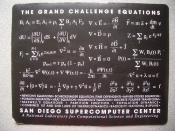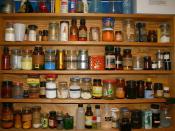Purpose: To find number of moles of Fe+3 which react with one mole of NH3OH+ in order to partially balance the equation: NH3OH+ + 2Fe+3 "" ? + 2Fe+2 and to find the missing product.
Procedure: H2C2O4 and H2SO4 were titrated with potassium permanganate. The molarity of the permanganate was then found because the molarity of the H2C2O4 and H2SO4 were already known. Then hydroxylammonium chloride and ferric sulfate and water was titrated with known potassium permanganate to get the molarity of the hydroxylammonium chloride and ferric sulfate solution, and that was used to find the number of moles of Fe+3 which reacts with one mole of NH3OH+ to find the missing part of the equation.
Calculations: 0.103 moles/1000 mL = .00103 moles/10 mL
.00103 x (2/5) = .000412/16 mL = .0256 M
.0256 moles/1000 mL = 1.95 x 10-4 moles / 7.6 mL
(1.95 x 10-4) x 5 = 9.75
x 10-4 moles = moles of Fe+2
.05 moles/1000 mL = .0005 moles/10 mL = moles of hydroxylammonium chloride
Ratio of Fe+2 to NH3OH+ = 2:1
2e- + 2Fe+3 --> 2Fe+2 so transfer of 2 electrons
NH3OH+ --> something + 2e-
Oxidation number of N in NH3OH+ is -1, therefore the oxidation number for N on the product side must be +1 because it gains 2 electrons.
N2O has an oxidation number of +1 for N, so that would work.
Data:Equation 1: NH3OH+ + 2Fe+3 --> something + 2Fe+2
Equation 2: 8H+ + 5Fe+2 + MnO4- --> 5Fe+3 + Mn+2 + 4H2O
Equation 3: 6H+ + 2MnO4- + 5H2C2O4 --> 2Mn+2 + 10CO2 + 8H2O
Conclusion: Therefore the concluded reaction would be:
NH3OH+ + 2Fe+3 --> N2O + 2Fe+2
This was obtained by using stoichiometry half reactions the product of that reaction was determined to...



"Stoichiometry of an Oxidation-Reduction Reaction"
To make this better for a more universal aspect...you could have explained what some of the terms were like I assume some don't know what "molarity" is, that would have made it better...but I geuss for your class lab report that doesn't matter...oh well, nevermind that suggestion.
2 out of 3 people found this comment useful.